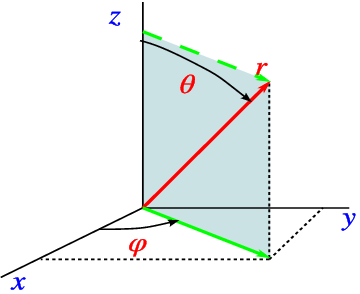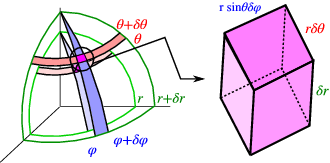7.2: Spherical Coordinates
( \newcommand{\kernel}{\mathrm{null}\,}\)
Spherical coordinates are defined from Cartesian coordinates as
r=√x2+y2+z2ϕ=arctan(y/x)θ=arctan(√x2+y2z)
or alternatively
x=rcosϕsinθ,y=rsinϕsinθz=rcosθ
as indicated schematically in Fig. 7.2.1.

Using the chain rule we find
∂∂x =∂r∂x∂∂r +∂ϕ∂x∂∂ϕ +∂θ∂x∂∂θ =xr∂∂r −yx2+y2∂∂ϕ +xzr2√x2+y2∂∂θ =sinθcosϕ∂∂r −sinϕrsinθ∂∂ϕ +cosϕcosθr∂∂θ ,∂∂y =∂r∂y∂∂r +∂ϕ∂y∂∂ϕ +∂θ∂y∂∂θ =yr∂∂r +xx2+y2∂∂ϕ +yzr2√x2+y2∂∂θ =sinθsinϕ∂∂r +cosϕrsinθ∂∂ϕ +sinϕcosθr∂∂θ ,∂∂z =∂r∂z∂∂r +∂ϕ∂z∂∂ϕ +∂θ∂z∂∂θ =zr∂∂r −√x2+y2r2∂∂θ =sinθsinϕ∂∂r −sinθr∂∂θ .
once again we can write ∇ in terms of these coordinates.
∇=ˆer∂∂r +ˆeϕ1rsinθ∂∂ϕ +ˆeθ1r∂∂θ where the unit vectors ˆer=(sinθcosϕ,sinθsinϕ,cosθ),ˆeϕ=(−sinϕ,cosϕ,0),ˆeθ=(cosϕcosθ,sinϕcosθ,−sinθ).
are an orthonormal set. We say that spherical coordinates are orthogonal.
We can use this to evaluate Δ=∇2,
Δ=1r2∂∂r (r2∂∂r )+1r21sinθ∂∂θ (sinθ∂∂θ )+1r2∂2∂ϕ2
Finally, for integration over these variables we need to know the volume of the small cuboid contained between r and r+δr, θ and θ+δθ and ϕ and ϕ+δϕ.

The length of the sides due to each of these changes is δr, rδθ and rsinθδθ, respectively (these are the Jacobians for the conversion of Cartesian coordinates to polar and spherical coordinates, respectively). We thus conclude that
∫Vf(x,y,z)dxdydz=∫Vf(r,θ,ϕ)r2sinθdrdθdϕ.


